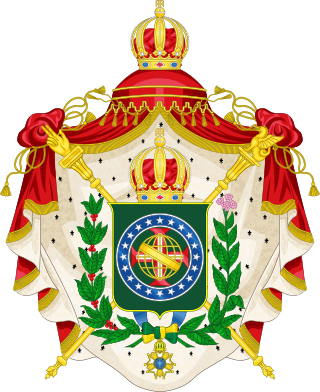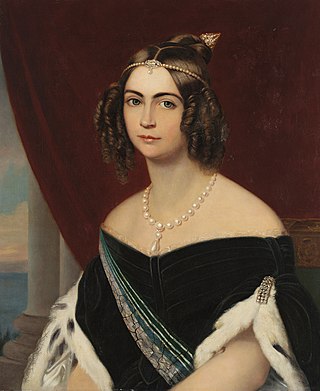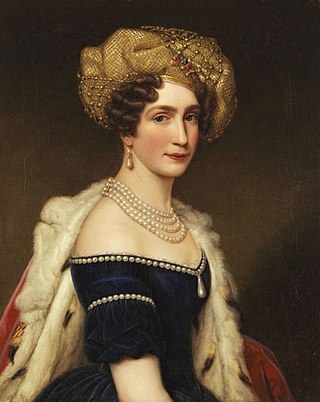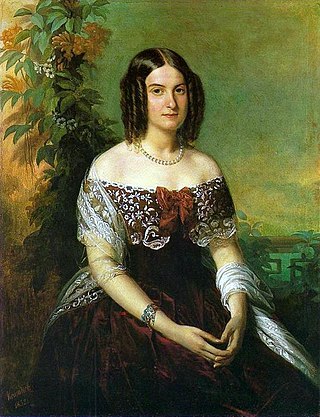Isabel Maria de Alcântara, Duchess of Goiás
Last updatedIsabel Maria | |
|---|---|
| Duchess of Goiás Countess of Treuberg Baroness of Holzen | |
 The Duchess of Goiás, by Wagner, 1853. | |
| Full name | Isabel Maria de Alcântara Brasileira |
| Born | 3 May 1824 Rio de Janeiro, Empire of Brazil |
| Died | 3 November 1898 (aged 74) Murnau am Staffelsee, Kingdom of Bavaria |
| Spouse(s) | Ernst Joseph Johann Fischler von Treuberg, 2nd Count of Treuberg and Baron of Holzen (m. 1843;died 1867) |
| Issue | Marie Amélie Fischler von Treuberg Ferdinand Fischler von Treuberg Augusta Maria Fischler von Treuberg Franz Xavier Fischler von Treuberg |
| Father | Pedro I of Brazil |
| Mother | Domitila de Castro Canto e Melo |
Isabel Maria de Alcântara, 1st and only Duchess of Goiás (3 May 1824 – 3 November 1898), was a Brazilian noble, the recognized daughter, born out of wedlock, of Emperor Pedro I of Brazil and Domitila de Castro, Marchioness of Santos, having been baptized on 31 May 1824.
Contents
- Life
- Birth and baptism
- Recognition by the Emperor
- Studies in Europe
- Marriage
- Relationship with the Duchess of Bragança
- Widowhood and later years. Death
- Titles
- Ancestry
- Notes
- References
- Bibliography
She was legitimized, or recognized as a daughter of the Emperor, on 24 May 1826, by a decree who granted her the noble title of Duchess of Goiás and the right to be treated as "Her Highness, The Duchess of Goiás", treatment that would be unexpected and even irregular by Iberian monarchical traditions. Thanks to this, an order was sent to the headquarters of the Armed Forces of Brazil to salute the girl. She was thus, in practice, treated as a Brazilian princess (although these honors did not confer on her any place in the line of succession) and was considered in the First Reign of the Empire of Brazil a kind of protector of the province of Goiás.
Life
Birth and baptism
Isabel Maria was born in the city of Rio de Janeiro on 3 May 1824 and was registered as the daughter of unknown parents who would have been abandoned at the home of Colonel João de Castro (in fact, her maternal grandfather). In this condition, she was baptized twenty-eight days later, on 31 May, in the church of São Francisco Xavier do Engenho Velho, having as her godparents the parents of the Marchioness of Santos. [1] Just before her two-year birthday, Emperor Pedro I publicly acknowledged his paternity (being the only one among his illegitimate offspring who was officially legitimized by him [2] ) and demanded that the alteration of the child's baptism seat to prove it. [lower-alpha 1]
Recognition by the Emperor
By a decree dated 24 May 1826, Emperor Pedro I of Brazil granted Isabel Maria the title of "Duchess of Goiás", the style of Highness and the right to use the honorific "Dona" (Lady), [2] [4] being the first person to hold the ducal rank in the newly Empire of Brazil. [5] The imperial decree caused a furor in the Brazilian court and the event was celebrated in a party with grand gala pomp, celebrated in the Palace of Caminho Novo, the imposing residence that the Emperor built for his mistress the Marchioness of Santos on the outskirts of the Palace of São Cristóvão. [6] [lower-alpha 2]
On 6 June 1826 and before the entire court, Isabel Maria was officially introduced to the Empress consort Maria Leopoldina of Austria. From then on, the Duchess of Goiás began to attend the palace daily to be educated along with her paternal half-sisters, the legitimate daughters of the imperial couple. [8]
Following the death of Empress Maria Leopoldina in December 1826, Isabel Maria was taken to live permanently with her father at the Palace of São Cristóvão in August 1827. [9] In 1829 Emperor Pedro I remarried and definitively broke up his relationship with the Marchioness of Santos, who was sent back to the city of São Paulo. The new Empress consort, Amélie of Leuchtenberg, had already made it clear that she would not allow that the illegitimate daughter of her husband would remain in the Palace of São Cristóvão and even before her arrival in Brazil, Isabel Maria had to be transferred to the Palace of Praia Grande, the official imperial summer residence, in the city of Niterói, located in the state of Rio de Janeiro. [9]
Studies in Europe
Emperor Pedro I decided to send his legitimized daughter to be educated in Europe; on 25 November 1829, 5-years-old Isabel Maria embarked to France, taking a letter from secretary Francisco Gomes to the Viscount of Pedra Branca with the recommendation that her academical instruction should be "the best possible to make a nun, with the least possible expense, without however lacking the decency due to a daughter His Imperial Majesty, since she is a bastard". [10] The voyage had numerous mishaps: a storm damaged the sails of the ship, its occupants were affected by an outbreak of fever and the little Duchess of Goiás began to complain of chest pain. In view of this situation, Paulo Martins de Almeida, [lower-alpha 3] responsible for the girl, ordered the commander of the ship to change the course to the city of Plymouth, where they landed on 8 February 1830. [10] The cortege settled in London, while the Viscounts of Itabaiana and of Resende sought in the city of Paris one school suitable for the education of Isabel Maria. [10]
Isabel Maria was finally taken to the city of Paris in France, and went on to study in the Ecole du Sacre-Coeur (now Musée Rodin), a boarding school where the daughters of the French Catholic aristocracy were educated. [lower-alpha 4] In Brazil, Emperor Pedro I received monthly medical reports and information on his daughter's development. The nuns responsible for the school reported that the Duchess of Goiás was extremely docile and, with the exception of the piano, had been doing well in all subjects. However, they also reported that it was given to mood swings when forced to study. [10]
On 7 April 1831, Emperor Pedro I abdicated the throne of Brazil and left for Europe with his wife Amélia de Leuchtenberg and his eldest legitimate daughter Queen Maria II of Portugal. Shortly after a few months as a guest of King Louis Philippe I, the former Emperor and now Duke of Bragança acquired a home and Isabel Maria began to spend the weekends with her family. [12] This time, Amélie of Leuchtenberg accepted her and ended up adopting her as a daughter. On January 25, 1832, the Duke of Bragança went to Portugal to retake the throne usurped by his younger brother Miguel, leaving Isabel Maria in the care of his wife and mother-in-law, Princess Augusta of Bavaria, Dowager Duchess of Leuchtenberg. [13] Soon after the constitutional forces conquered Lisbon, the Duke of Bragança sent his brother-in-law, the Marquis of Loulé, to Paris to bring his wife and daughter Queen Maria II for Portuguese territory. [14] The Duchess of Goiás, on that occasion, returned to the boarding school.
The Duke of Bragança died on 24 September 1834 and the task of raise Isabel Maria was assumed by his widow and her mother; in his will, the Duke gave his daughter a share of his estate. [15] The Duchess of Goiás had been separated from the Marchioness of Santos at such a young age that she had no recollection of her biological mother and therefore she had always considered Amélie of Leuchtenberg and Dowager Duchess Augusta of Leuchtenberg as her natural mother and grandmother. [16] In 1839, under the tutelage of the Marquis of Resende, Isabel Maria went to Munich and joined the Royal Institute of Young Women to complete her studies. [17] [18] In 1841, Amélie of Leuchtenberg sent news of her progress to her stepson, Emperor Pedro II: "Everyone is very happy with Isabel Maria at the institute, and my mother wrote that she grows and becomes more beautiful every day". [17]
Marriage
At that time, Amélie of Leuchtenberg started looking for a suitable husband for her stepdaughter. Although she received a considerable inheritance from her father, Isabel Maria's dowry was provided by her siblings: Emperor Pedro II of Brazil, Queen Maria II of Portugal and by her own stepmother, who personally took care of her wedding trousseau. [17]
In 1842, the Duchess of Bragança informed the Emperor of Brazil that she had arranged for the Duchess of Goiás to marry Ernst Joseph Johann Fischler von Treuberg, 2nd Count of Treuberg and Baron of Holzen, son of Franz Xavier Nicolau Fischler von Treuberg (1775-1835) and his wife Princess Maria Kreszentia of Hohenzollern-Sigmaringen (1766-1844), youngest daughter of Karl Friedrich, Prince of Hohenzollern-Sigmaringen. [19] [20] Thirteen years older than the Brazilian Duchess, the Count was a wealthy landowner and related to the Prussian royal family on his mother's side. In November of that year, Amélie of Leuchtenberg asked Pedro II of Brazil to grant the Imperial Order of the Rose to Isabel Maria's future husband. [17]

The wedding ceremony took place at the Palais Leuchtenberg in Munich on 17 April 1843. [17] Due to her marriage to a foreigner, Isabel Maria lost her Brazilian title and honors. [21] [22] The couple had four children:
- Marie Amélie Fischler von Treuberg (6 February 1844 – 30 March 1919).
- Ferdinand Fischler von Treuberg (24 January 1845 – 3 July 1897), 3rd Count of Treuberg and Baron of Holzen; married Rosine Antonie Therese, Edle von Poschinger. Had issue. [23]
- Augusta Maria Fischler von Treuberg (8 October 1846 – 16 August 1909), married Maximilian, Baron Tänzl von Tratzberg. [24]
- Franz Xavier Fischler von Treuberg (2 July 1855 – 1 February 1933), married firstly Karoline von Wendt and secondly to his first wife's sister, Ludovika Manuela Maria von Wendt. Had issue in both marriages.
Relationship with the Duchess of Bragança
In 1848 and shortly after marrying with Maria Isabel de Alcântara (full-sister of the Duchess of Goiás), Pedro Caldeira Brant, Count of Iguaçu, tried to contact his sister-in-law in Bavaria. Isabel Maria, who had no recollection of her maternal family, was shocked when she received from the Count, as proof of her biological ancestry, the letters exchanged between Emperor Pedro I of Brazil and the Marchioness of Santos in which the lovers mentioned their daughter. [25] The story, which had been hidden from the Duchess of Góias by the express wish of the late former Emperor and Duke of Bragança, ended up initially shaking the family relationship that Isabel Maria had with her stepmother Amélie of Leuchtenberg, whom she considered her mother. [25]
Widowhood and later years. Death
The 2nd Count of Treuberg died on 14 May 1867, just six months before the death of his mother-in-law, the Marchioness of Santos. Isabel Maria de Alcântara (who remained in Europe and never returned to her homeland), died at Murnau am Staffelsee in the Kingdom of Bavaria, on 3 November 1898, exactly 31 years after her mother's death.
Titles
- 24 May 1826 – 17 April 1843: Her Highness The Duchess of Goiás
- 17 April 1843 – 3 November 1898: The Countess of Treuberg, Baroness of Holzen
Ancestry
| Ancestors of Isabel Maria de Alcântara, Duchess of Goiás | |||||||||||||||||||||||||||||||||||||||||||||||||||||||||||||||||||||||||||||||||||||||||||||||||||||||||||||||||||||||||||||||||||||||||||||||||||||||||||||||||||||||||||||||||||||||||||||||||||||||||||||||||||||||||||||||||||||||||||||||||||||||||||||||||||||||||||||||||||||||||
|---|---|---|---|---|---|---|---|---|---|---|---|---|---|---|---|---|---|---|---|---|---|---|---|---|---|---|---|---|---|---|---|---|---|---|---|---|---|---|---|---|---|---|---|---|---|---|---|---|---|---|---|---|---|---|---|---|---|---|---|---|---|---|---|---|---|---|---|---|---|---|---|---|---|---|---|---|---|---|---|---|---|---|---|---|---|---|---|---|---|---|---|---|---|---|---|---|---|---|---|---|---|---|---|---|---|---|---|---|---|---|---|---|---|---|---|---|---|---|---|---|---|---|---|---|---|---|---|---|---|---|---|---|---|---|---|---|---|---|---|---|---|---|---|---|---|---|---|---|---|---|---|---|---|---|---|---|---|---|---|---|---|---|---|---|---|---|---|---|---|---|---|---|---|---|---|---|---|---|---|---|---|---|---|---|---|---|---|---|---|---|---|---|---|---|---|---|---|---|---|---|---|---|---|---|---|---|---|---|---|---|---|---|---|---|---|---|---|---|---|---|---|---|---|---|---|---|---|---|---|---|---|---|---|---|---|---|---|---|---|---|---|---|---|---|---|---|---|---|---|---|---|---|---|---|---|---|---|---|---|---|---|---|---|---|---|---|---|---|---|---|---|---|---|---|---|---|---|---|---|---|---|
| |||||||||||||||||||||||||||||||||||||||||||||||||||||||||||||||||||||||||||||||||||||||||||||||||||||||||||||||||||||||||||||||||||||||||||||||||||||||||||||||||||||||||||||||||||||||||||||||||||||||||||||||||||||||||||||||||||||||||||||||||||||||||||||||||||||||||||||||||||||||||
Notes
- ↑ The alteration in the baptism seat was initially rejected by José Caetano da Silva Coutinho, Bishop of Rio de Janeiro and Major Chaplain of the Royal Chapel, which generated friction with the Emperor. The sovereign's demand was only met on 28 May 1826, after the declaration of paternity was sent to the church of São Francisco Xavier do Engenho Velho. Thus, the following note was included in the baptism seat: [3]
"I certify that on the 28th of the current month of May of the year 1826, arrived at the house of my residence, next to the diocese of São Francisco Xavier do Engenho Velho, the junior Graduate Officer of the Secretariat of Business in the Empire, Commander Francisco Gomes da Silva, telling me that His Majesty, the Emperor, ordered me to make a note on the seat of the baptism of the innocent Isabel, who was baptized in this diocese, on 31 May 1824, declaring to me together that the same Mighty Lord RECOGNIZED for his daughter the same mentioned innocent, the Lady Isabel Maria de Alcântara, and soon handed me a certificate in which she justified this, made by a Minister of State and signed by others immediately declared below and they were: the Viscount of Inhambupe, Minister of Foreigners; the Baron of Lages, Minister of War; the Viscount of São Leopoldo, Minister of the Empire. As a consequence, therefore, of the aforementioned order of His Majesty, the Emperor, and summoned by the aforementioned Commander Francisco Gomes da Silva, and of the said certificate, I proceeded to reform the seat in question, which I all affirm in fide Parochi. The Vig. MJ Roiz Dantas".
- ↑ The mourning for the death of King John VI of Portugal was slowed down for the event, where ministers and members of the nobility were present. In an attempt to diminish the scandal generated by the recognition of paternity and the granting of the title, secretary Francisco Gomes da Silva published an article in the Diário Fluminense where he cited the example of other monarchs who acted in the same way as the Emperor, like the French monarchs Henry IV and Louis XIV. [7]
- ↑ Created Viscount of Almeida by Imperial Decree of 14 March 1846 and Viscount with Greatness by Imperial Decree of 24 July 1872. [11]
- ↑ A few years later, Isabel Maria would have as a colleague in the Ecole du Sacre-Coeur the Countess of Teba, Eugenia de Montijo, future Empress of the French as the wife of Napoleon III. [10]
Related Research Articles

DomPedro I was the founder and first ruler of the Empire of Brazil, where he was known as "the Liberator". As King Dom Pedro IV, he reigned briefly over Portugal, where he also became known as "the Liberator" as well as "the Soldier King". Born in Lisbon, Pedro I was the fourth child of King Dom John VI of Portugal and Queen Carlota Joaquina, and thus a member of the House of Braganza. When the country was invaded by French troops in 1807, he and his family fled to Portugal's largest and wealthiest colony, Brazil.

Dona Maria II "the Educator" or "the Good Mother", was Queen of Portugal from 1826 to 1828, and again from 1834 to 1853.

Dona Maria Leopoldina of Austria was the first Empress of Brazil as the wife of Emperor Dom Pedro I from 12 October 1822 until her death. She was also Queen of Portugal during her husband's brief reign as King Dom Pedro IV from 10 March to 2 May 1826.

Domitilade Castro do Canto e Melo, 1st Viscountess with designation as a Grandee, then 1st Marchioness of Santos, was a Brazilian noblewoman and the long-term mistress and favorite of Emperor Pedro I.

The Imperial House of Brazil is a Brazilian dynasty of Portuguese origin that ruled the Brazilian Empire from 1822 to 1889, from the time when the then Prince Royal Dom Pedro of Braganza declared Brazil's independence, until Dom Pedro II was deposed during the military coup that led to the Proclamation of the Republic in 1889.

Amélie of Leuchtenberg was Empress of Brazil as the wife of Pedro I of Brazil.

Prince Pedro Henrique of Orléans-Braganza, nicknamed The Expected Prince was the eldest son of Prince Luís of Orléans-Braganza and Princess Maria di Grazia of Bourbon-Two Sicilies, and head of the Vassouras branch of the Imperial House of Brazil from 1921 until his death in 1981.

Princess Leopoldina of Brazil was the daughter of Emperor Pedro II and Empress Teresa Cristina. She shared the first name of her grandmother, Empress Maria Leopoldina of Brazil.

The House of Orléans-Braganza is by legitimacy, the imperial house of Brazil formed in 1864, with the marriage of the heir to the Brazilian throne, Isabel of Braganza with Prince Gaston, Count of Eu. The House of Orléans-Braganza never reigned, as Brazil's pure Braganza monarch, Emperor Pedro II being deposed in a military coup d'état, under the pressure of the civilian republicans, in 1889. However, with the death of Isabel in 1921, as the last Brazilian pure Braganza, her descendants inherited the dynastic rights of the Brigantine dynasty over the defunct Brazilian throne.

Dona Paula was a princess of the Empire of Brazil and thus, a member of the Brazilian branch of the Portuguese House of Braganza. Her parents were Emperor Dom Pedro I, the first ruler of an independent Brazil, and Archduchess Leopoldina of Austria. Born in Rio de Janeiro, Paula was the couple's fifth child and third daughter child; she lost her mother at the age of three and her father at the age of eight, when he abdicated and left Brazil for Portugal, where he wanted to restore the throne of Paula's eldest sister, Maria da Glória, who should have become queen regnant of Portugal.

Princess Augusta of Bavaria, Duchess of Leuchtenberg was the second child and eldest daughter of Maximilian I Joseph of Bavaria and Princess Augusta Wilhelmina of Hesse-Darmstadt. By marriage, she was a French princess.
Dona Maria Amélia was a princess of the Empire of Brazil and a member of the Brazilian branch of the House of Braganza. Her parents were Emperor Dom Pedro I, the first ruler of Brazil, and Amélie of Leuchtenberg. The only child of her father's second marriage, Maria Amélia was born in France after Pedro I abdicated the Brazilian throne in favor of his son Dom Pedro II. Before Maria Amélia was a month old, Pedro I went to Portugal to restore the crown of the eldest daughter of his first marriage, Dona Maria II. He fought a successful war against his brother Miguel I, who had usurped Maria II's throne.

The Imperial Order of the Rose was a Brazilian order of chivalry, instituted by Emperor Pedro I of Brazil on 17 October 1829 to commemorate his marriage to Amélie of Leuchtenberg.

Dom Afonso was the Prince Imperial and heir apparent to the throne of the Empire of Brazil. Born in Rio de Janeiro, he was the eldest child of Emperor Dom Pedro II and Dona Teresa Cristina of the Two Sicilies, and thus a member of the Brazilian branch of the House of Braganza.

The Brazilian nobility refers to the titled aristocrats and fidalgo people and families recognized by the Kingdom of Brazil and later, by the Empire of Brazil, dating back to the early 19th century, when Brazil ceased to be a colony of the Kingdom of Portugal. It held official status until 1889, when a military coup d'état overthrew the monarchy and established the First Brazilian Republic.

The Pantheon of the House of Braganza, also known as the Pantheon of the Braganzas, is the final resting place for many of the members of the House of Braganza, located in the Monastery of São Vicente de Fora in the Alfama district of Lisbon, Portugal. The pantheon's burials have included Portuguese monarchs, Brazilian monarchs, a Romanian monarch, queen consorts of Portugal, and notable Infantes of Portugal, among others.

The Monument to the Independence of Brazil is a granite and bronze monument located in the Independence Park in São Paulo, Brazil. It is also known as the Ipiranga Monument or the Altar of the Fatherland. The monument is located on the banks of the Ipiranga Brook, on the historic site where prince regent Pedro proclaimed the independence of the country on 7 September 1822.

Maria Isabel de Alcântara Bourbon was the third daughter of emperor Pedro I of Brazil and his mistress, Domitila de Castro, Marchioness of Santos.

Luísa Margarida de Barros Portugal, later Countess of Barral, was a Brazilian noble and courtier, preceptor of Brazilian princesses Isabel and Leopoldina, rumored to be the major love interest of Pedro II of Brazil and later part of Louis Philippe I of France's court.

Independência ou Morte is a Brazilian Historical drama film directed by Carlos Coimbra and released on September 2, 1972. is based on the life of Emperor Pedro I of Brazil and Empress Maria Leopoldina of Austria, as well as other facts about the Independence of Brazil, is starring Tarcísio Meira, Glória Menezes, Kate Hansen and Dionísio Azevedo.
References
- ↑ Rezzutti 2015, p. 181.
- 1 2 Sousa 1972, Vol 2, p. 229.
- ↑ Setúbal, Paulo (2009). 1813-1829: a Marquesa de Santos (in Portuguese). São Paulo: Geração Editorial. ISBN 978-85-61501-84-6.
- ↑ "Decreto de 24 de maio de 1826 - Concede o título de Duqueza de Goyas a D. Izabel Maria de Alcantara Brazileira" (PDF). Actos do Poder Executivo - Coleção das Leis do Império do Brasil - Câmara dos Deputados (in Portuguese). 1826. p. 41. Retrieved March 7, 2021.
- ↑ Viana 1968, p. 204.
- ↑ Rezzutti, Paulo (2013). Domitila: A verdadeira história da marquesa de Santos (in Portuguese). São Paulo: Geração Editora. ISBN 978-8581301044.
- ↑ Gomes da Silva, Francisco (10 June 1826). "Artigos nam Officiaes". Diário Fluminense (in Portuguese). 7 (128). Rio de Janeiro: 510. Retrieved March 7, 2021.
- ↑ Lustosa, Isabel (2006). D. Pedro I - Um herói sem nenhum caráter (in Portuguese). São Paulo: Companhia das Letras. ISBN 978-8580860061.
- 1 2 Rezzutti 2015, p. 362.
- 1 2 3 4 5 Rezzutti 2015, p. 363.
- ↑ Smith de Vasconcellos, Rodolfo and Jaime (1918). Archivo Nobiliarchico Brasileiro (in Portuguese). Lausanne: Imprimerie La Concorde. p. 38. ISBN 9785881360122 . Retrieved March 7, 2021.
- ↑ Rezzutti 2015, p. 296.
- ↑ Rezzutti 2015, p. 300.
- ↑ Rezzutti 2015, p. 319.
- ↑ Rangel 1928, p. 447.
- ↑ Rezzutti 2015, pp. 363–365.
- 1 2 3 4 5 Rezzutti 2015, p. 364.
- ↑ Vilaça, Fabiano (3 January 2011). "A prole bastarda e imperial". Revista de História (in Portuguese). Fundação Biblioteca Nacional. Archived from the original on August 6, 2016. Retrieved March 7, 2021.